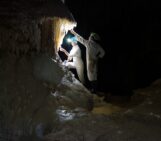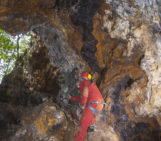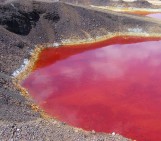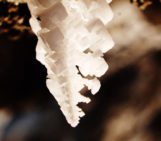
The picture was taken in Salina Turda, a fascinating salt mine in western Transylvania, in Durgău – Valea Sarată near Turda city. In the picture, the pockets created by salt dissolution can be observed. Over time, due to the erosive power of air currents, the walls have been reshaped: the corners have been rounded and, at the contact between the roof and the walls, a series of dissolution pockets form. The pockets are created by the effect of the water, found in the moist atmospheric air, which enters the underground cavern. At the base of the walls a consistent layer of recrystallized salt forms due to the slow trickling down of the condensed vapor a long the walls.
Salt deposits from Transylvania belong to an evaporitic horizon overlaid on the entire surface of the basin. Recent geological research enforces the idea that the leading cause for salt precipitation was the isolation from the Pannonian Basin of the Transylvanian Basin; an isolation which took place during the latest Badenian sea-level low stand (some 13.6 to 13.4 million years ago), in a warm and wet climate, not too dissimilar to the modern-day Mediterranean climate.
It is thought that the exploitation of the salts deposits began during the Roman occupation in Dacia, but the first written documents that mention systematic exploitation of the mine by means of underground mining date back only to 1271.
Turda salt mine ceased activity in 1932. During World War II the mine was used as a bomb shelter. In addition, between 1948-1992, the Franz Josef gallery was used as a storeroom for cheese. In 1992, the salt mine opened its doors to tourists.
The mine has a unique microclimate; characterized by temperature ratings in the 11-12 ° C, relative humidity is about 80% and air pressure between 747-752 mmHg. Air ionization at moderate levels and the lack of pathogenic bacteria contribute to the curative effect of respiratory diseases.
Imaggeo is the EGU’s online open access geosciences image repository. All geoscientists (and others) can submit their photographs and videos to this repository and, since it is open access, these images can be used for free by scientists for their presentations or publications, by educators and the general public, and some images can even be used freely for commercial purposes. Photographers also retain full rights of use, as Imaggeo images are licensed and distributed by the EGU under a Creative Commons licence. Submit your photos at http://imaggeo.egu.eu/upload/.




